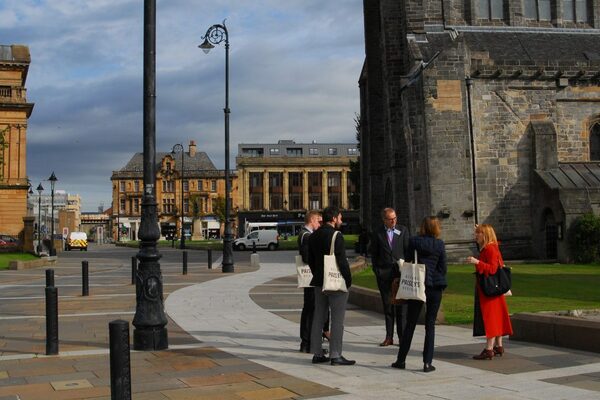Candidate: Paisley
Location: Renfrewshire, UK
Category: The Great Town Award (winner)
Year: 2019
Other Finalists in this category: Barnsley, South Yorkshire and Chelmsford, Essex
Assessment Summary
Paisley didn’t win the City of Culture 2018 but the process of developing their bid won over the people of Paisley and in turn permanently changed the narrative of the place and direction of travel. Their approach to town centre regeneration and addressing social deprivation is delivering impressive deep-rooted change. There is an energy and belief in the town which is widely evident, impressive and infectious.
The model for change that Paisley is using is sound, well thought through, and will continue to support the town in future decades. It is built on a strong vision and long-term ‘step change’ targets that align with the delivery timescales for the city region economic strategy. That is supported by targeted interventions to grow Paisley’s economy, tackle poverty and transform the built heritage and reputation of the place.
Paisley is Scotland’s largest town with a population of c. 75,000 people, with a large university population (the University of the West of Scotland has nearly 16,000 students). It is the administrative centre of Renfrewshire. Despite being on the doorstep of Glasgow – home to Glasgow International Airport and the fourth busiest railway station in Scotland – the town has a distinct identity from its neighbouring city. The well preserved and impressive public buildings in the town centre, funded by 19th century industrialists, are reminders of the town’s past as a significant textiles and weaving centre, mass producer of thread, home to Coates and Clarks, and most famously, the Paisley pattern.
Paisley slowly lost its thread industry and then its more recent car making and engineering facilities. Today just over 40% of Paisley’s population live in 20% of most deprived communities in Scotland. Paisley’s response has been to focus investment on its cultural assets to reconnect people from all social backgrounds to the town centre and with each other, to regenerate the town and to change its image as an example of urban decline to one of culture, creativity and vibrancy – an upcoming place in which to invest and live.
There is deep and meaningful working between the Council and communities. At a strategic level the Paisley Partnership Board brings together national and regional organisations across a range of sectors. In addition to Renfrewshire Council, board members include NHS, University of the West of Scotland, Glasgow School of Art, Scottish Enterprise, Skills Development Scotland, Creative Scotland, Visit Scotland, and representatives from local voluntary and community sector organisations. At the community level, decisions and energy is provided by local groups and enablers. This approach has delivered a range of projects from the redevelopment and growth of the University of the West of Scotland Campus, to the local social housing regeneration at Ferguslie where the council radically amended their redevelopment and rehousing plans to respond to what came out of community consultation.
Paisley’s Untold Story is inspiring a very wide range of projects from exciting community events, through creative reuse of buildings to the significant investment in Paisley Museum, part funded by Heritage Lottery (HLF) to create a new space to tell the Untold Story of the town’s history. The museum is an excellent example of taking significant town centre heritage buildings and using them as important focus points for commercial, cultural and community connection.
Socially, Paisley has a culture of community activism that goes back to the Paisley weavers who fought for their rights and for fair pay and became one of places to lay the foundations of the trade unions movement in the UK. The Sma’ Shot festival remains an annual celebration of the mill workers standing up for fair pay for their work. Those stories have been used as a way to reconnect people proudly with their past and reenergise people about their place.
The focus on the town centre is resulting in a more legible place with well-designed and maintained public spaces, (including for events), more town centre activity and town centre living and a good mix of buildings with uses other than retail, which is helping to build a more robust and economically sustainable town centre. The council has ensured that Paisley centre is supported and diversified through the inclusion of civil institutions, council projects, educational establishments and retail and residential concerns.
Outside the core in the historical hinterland, there is a local character in the detail of the landscape of local streets, the Museum and the Observatory. The strong town centre network of streets and spaces is enhanced by an urban path network, and National Cycle Routes 7 and 75. Overall, road and pedestrian and cycling connectivity could be improved, expanded and enhanced. This is recognised and some investment is planned.
The council has prioritised lifting the town out of poverty including delivering good social housing. The re-investment in council and social housing stock is impressive. Paisley is an outstanding example of how you can bring people and place together effectively and engage everyone on the journey of change and improvement.









